Once leaves fall from the trees and you cut back your flowering perennials in the autumn, your garden can look quite barren. But if you live along a busy street or in tight quarters in a neighborhood, the sudden loss of leaves and plants outdoors can leave your backyard feeling open and exposed. However, if you’ve planted the right privacy plants, you can keep your outdoor space feeling cozy and protected all year long.
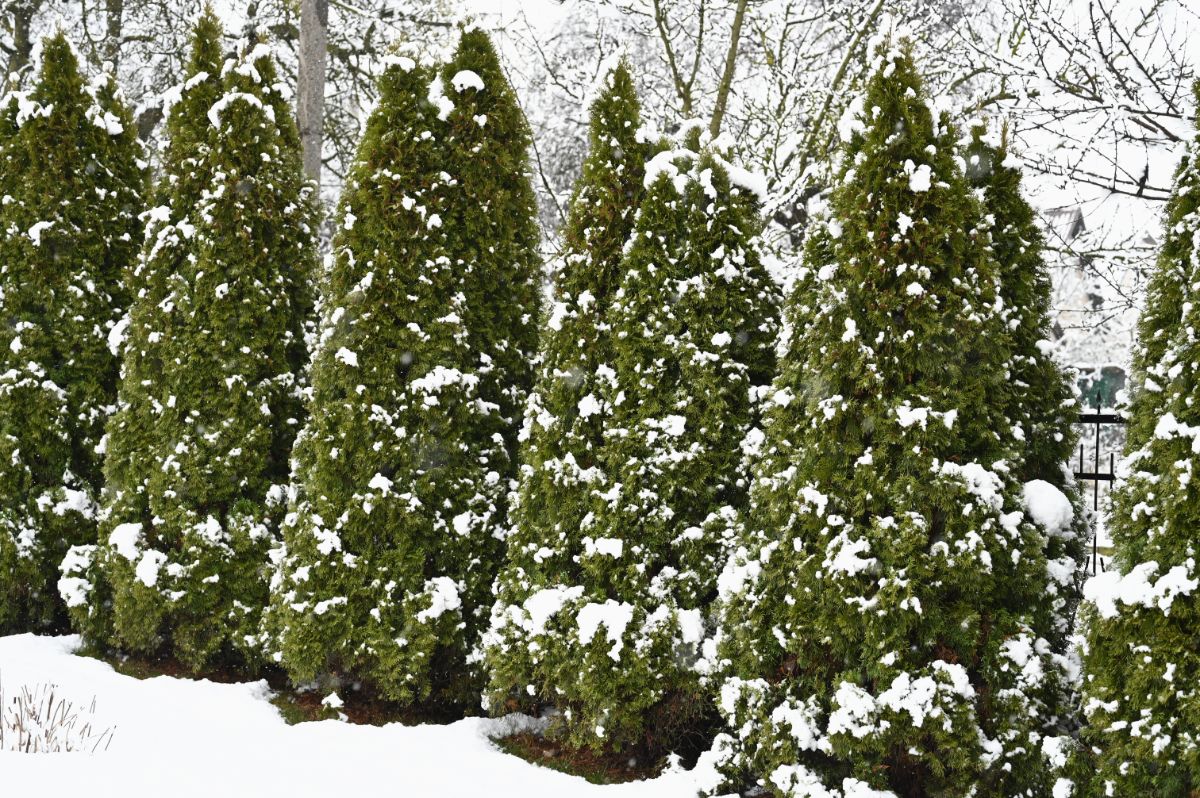
Because they keep their foliage throughout the winter, evergreen plants, shrubs, and trees are usually the best choices for creating winter privacy. However, there are some other easy-to-grow plants that can increase that peaceful, secluded feel many gardeners crave. Even better, privacy plants can be used to shield your home from the sights and sounds of busy roadways, cover up unsightly utility boxes, and so much more.
In this guide, we’ll discuss some of the best plants to grow to maintain that “oasis-like” feeling in your garden, spring through winter. Follow along with us and find the perfect privacy plants for your home!
Jump to:
- Best Garden Plants for Winter Privacy
- 1. Holly (Ilex aquifolium)
- 2. Arborvitae (Thuja occidentalis)
- 3. Ornamental Grasses
- 4. Privet (Ligustrum vulgare)
- 5. Bamboo (Bambusa spp.)
- 6. Boxwood (Buxus spp.)
- 7. Cotoneaster (Cotoneaster spp.)
- 8. Yew (Taxus baccata)
- 9. Mountain Laurel (Kalmia latifolia)
- 10. Azaleas and rhododendron (Rhododendron spp.)
- 11. Leyland cypress (Cupressus × leylandii)
- 12. Skip Laurel (Prunus laurocerasus 'Schipkaensis')
- 13. Juniper (Juniperus spp.)
- 14. Cedar (Juniperus virginiana, Thuja plicata, and others)
- 15. Other evergreens
- Frequently Asked Questions
- Summary
Best Garden Plants for Winter Privacy
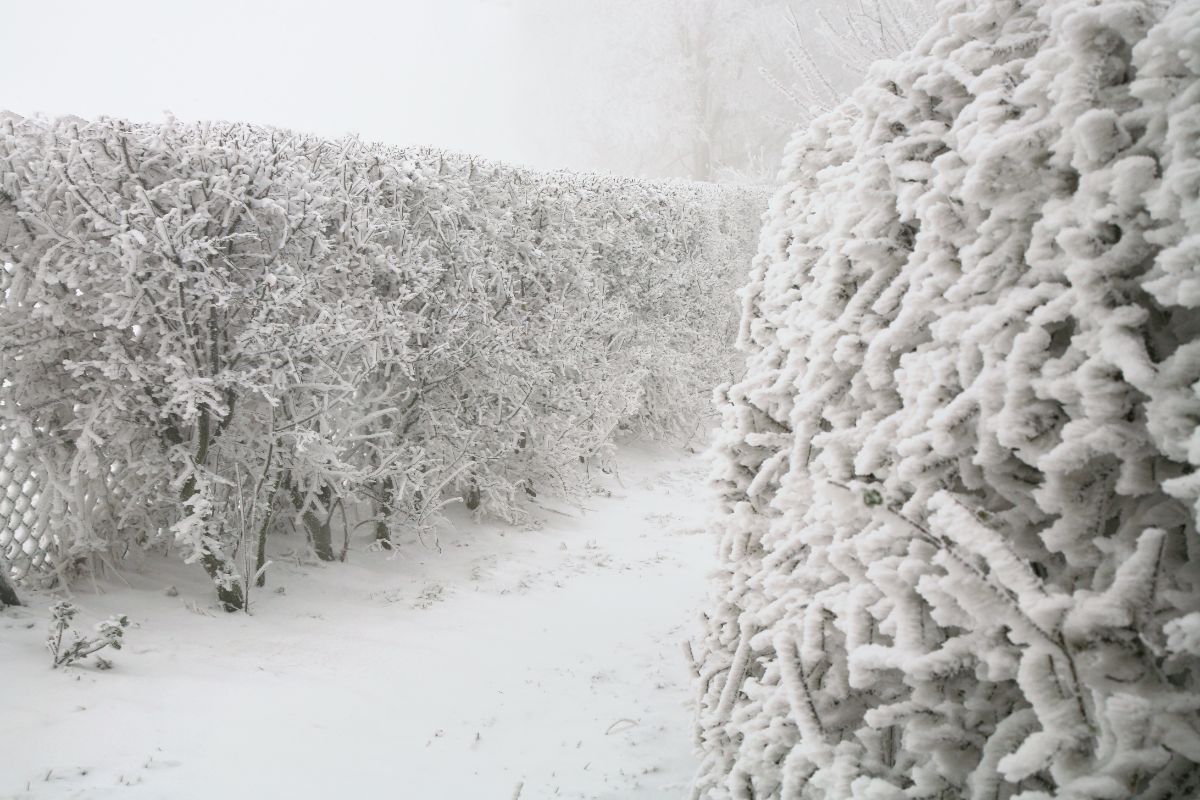
Below are some of the best plants to keep for winter privacy. While most of these plants are evergreens, we’ve chosen some other varieties of plants, too, to give you more options.
You’ll find plants for different growing zones, lot sizes, and soil types as well. And, of course, we’ve tried to include a varied selection to match any gardening interest or aesthetic style.
1. Holly (Ilex aquifolium)
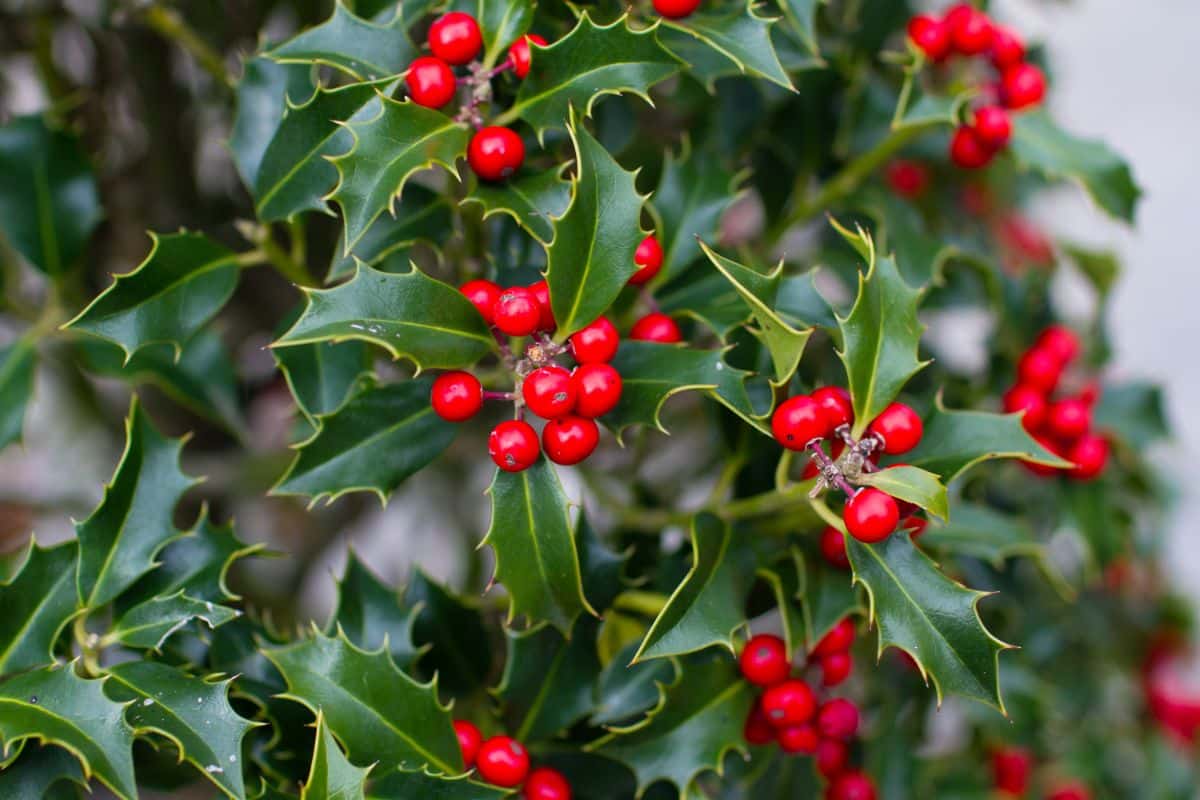
| Plant name: | Holly |
| Watering requirements: | Low |
| Lighting requirements: | Full sun to part shade |
| Growing zone: | Zones 5 to 9 |
| Other benefits: | Drought resistant; berries attract wild birds. |
Holly is a classic garden plant that looks gorgeous in winter or summer. Known for its distinct, glossy, and angular leaves, holly bushes bring even more color when they produce bright red berries in autumn and winter. Those berries are a much-coveted treat for wild birds in winter!
As a privacy screen, holly offers dense foliage for extra shelter and grows thick and tall – easily reaching up to 50’ high. Hollies are available as both trees and shrubs and come in different colors, too, including bushes with variegated leaves. Just keep in mind that if you want your hollies to produce berries, you will need both male and female plants.
Once the holidays arrive, you’ll be glad that you planted holly, as they make wonderful ingredients for homemade wreaths and garlands too.
2. Arborvitae (Thuja occidentalis)
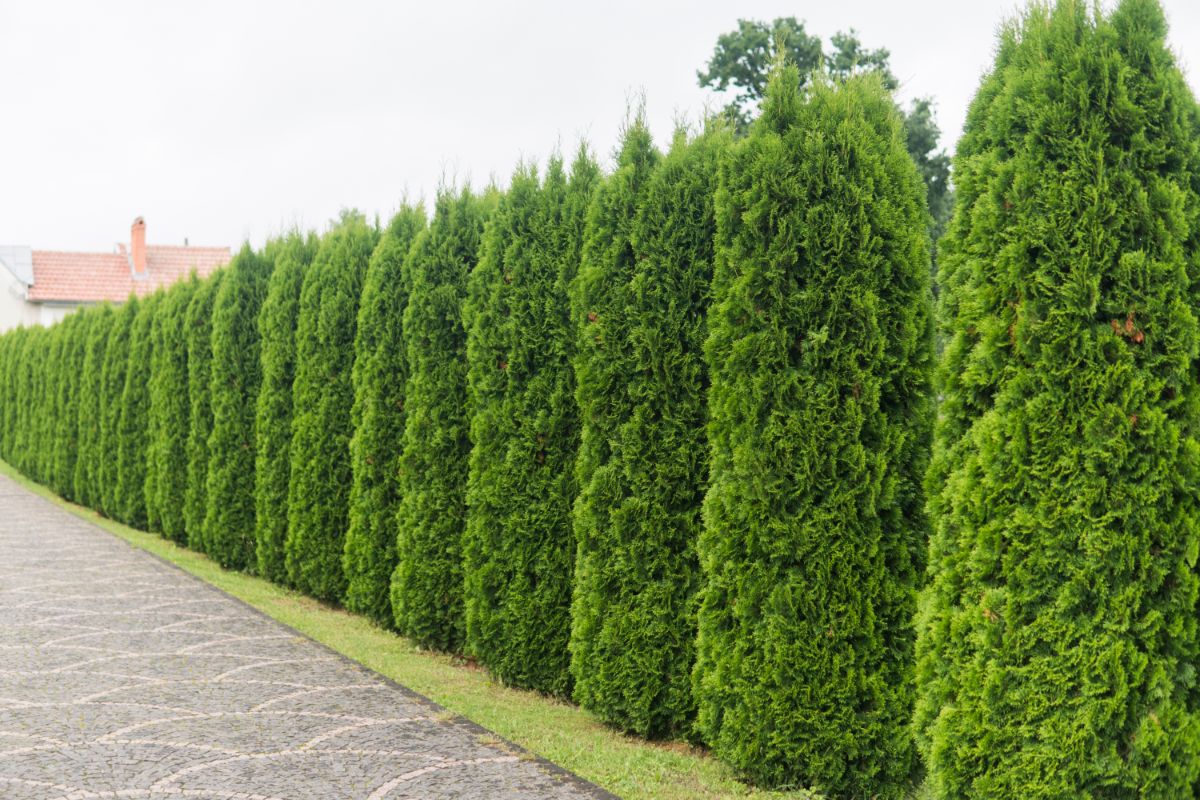
| Plant name: | Arborvitae |
| Watering requirements: | Moderate |
| Lighting requirements: | Full sun to part shade |
| Growing zone: | Zones 3 to 8 |
| Other benefits: | Cold hardy once established; moderate growth rate. |
No list of ‘top privacy plants’ would be complete without mentioning arborvitae. Wildly popular among backyard growers, arborvitae is often used as a living fence to keep prying eyes out and to create a clearly delineated garden space. And, as an evergreen, it will maintain its gorgeous green color all year long.
When properly spaced, arborvitae creates a thick, privacy hedge. While it can grow quite tall (up to 60’ high), dwarf varieties are also available if you're working with a smaller gardening space or container planter.
A relatively hardy plant, arborvitae can tolerate most garden soil types, and it can handle cold temperatures too. However, newly planted shrubs may benefit from winter wrapping with burlap to prevent damage. It's also important to keep new plantings well-watered to avoid browning leaves.
3. Ornamental Grasses
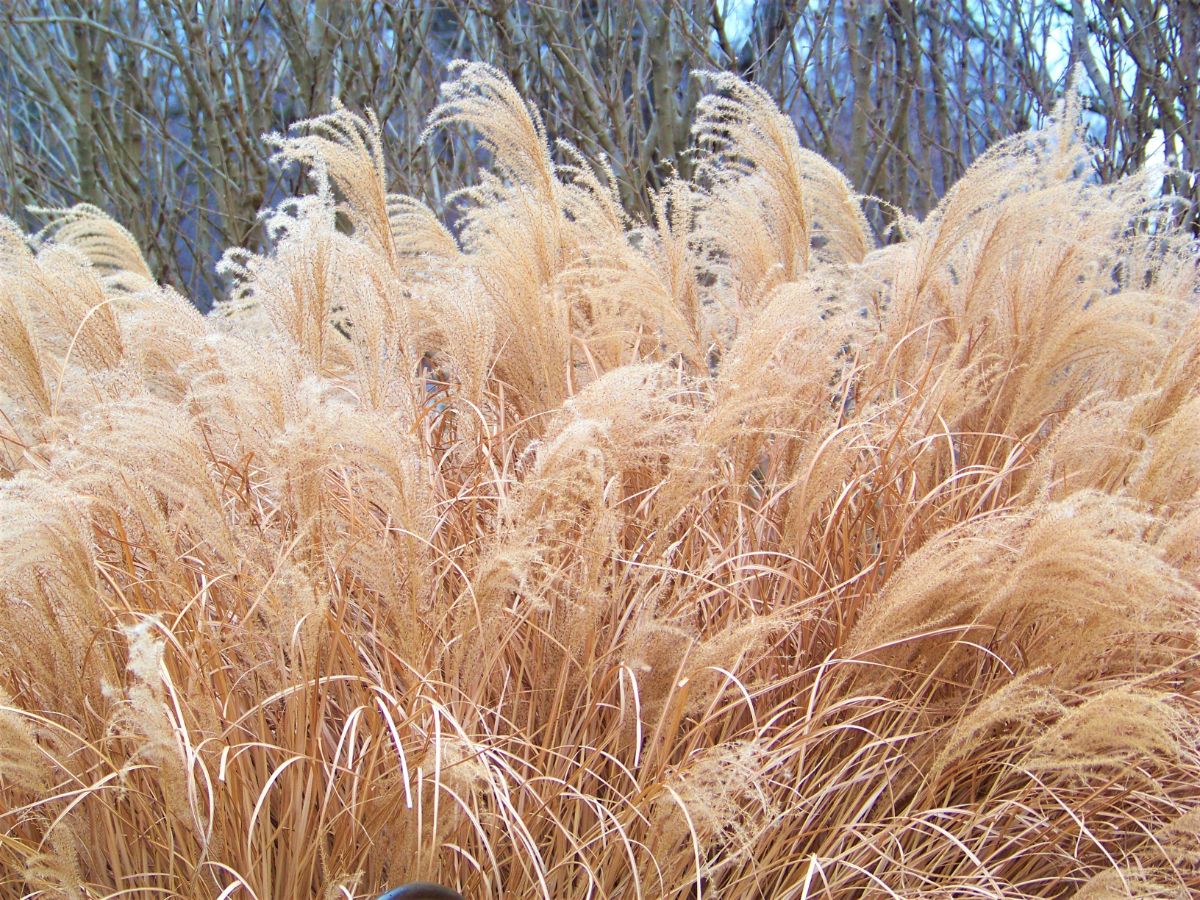
| Plant name: | Ornamental grasses |
| Watering requirements: | Low |
| Lighting requirements: | Full sun |
| Growing zone: | Depends on variety |
| Other benefits: | Seed heads attract birds. |
Depending on the type of ornamental grass you choose to grow, you can create quite an impressive privacy screen to shield your garden space all year. While there are, of course, shorter varieties, tall ornamental grasses can easily reach over 6’ high, providing you with lots of protection from hectic roads or neighboring yards.
Tall grass forms are usually ornamented by fluffy seed heads that add lots of texture to your garden space. Birds also love munching on those seeds during winter when other food sources are scarce.
Requiring very minimal maintenance, you can allow ornamental grasses to grow as they please or cut old growth back in early spring to prevent weeds from cropping up in the middle of your grassy patch. For better privacy, leave your grasses untouched in autumn. When your grass turns golden brown in winter, you’ll appreciate the extra garden color, and the seed heads will provide plenty of interest when ruffled about in the winter winds.
4. Privet (Ligustrum vulgare)
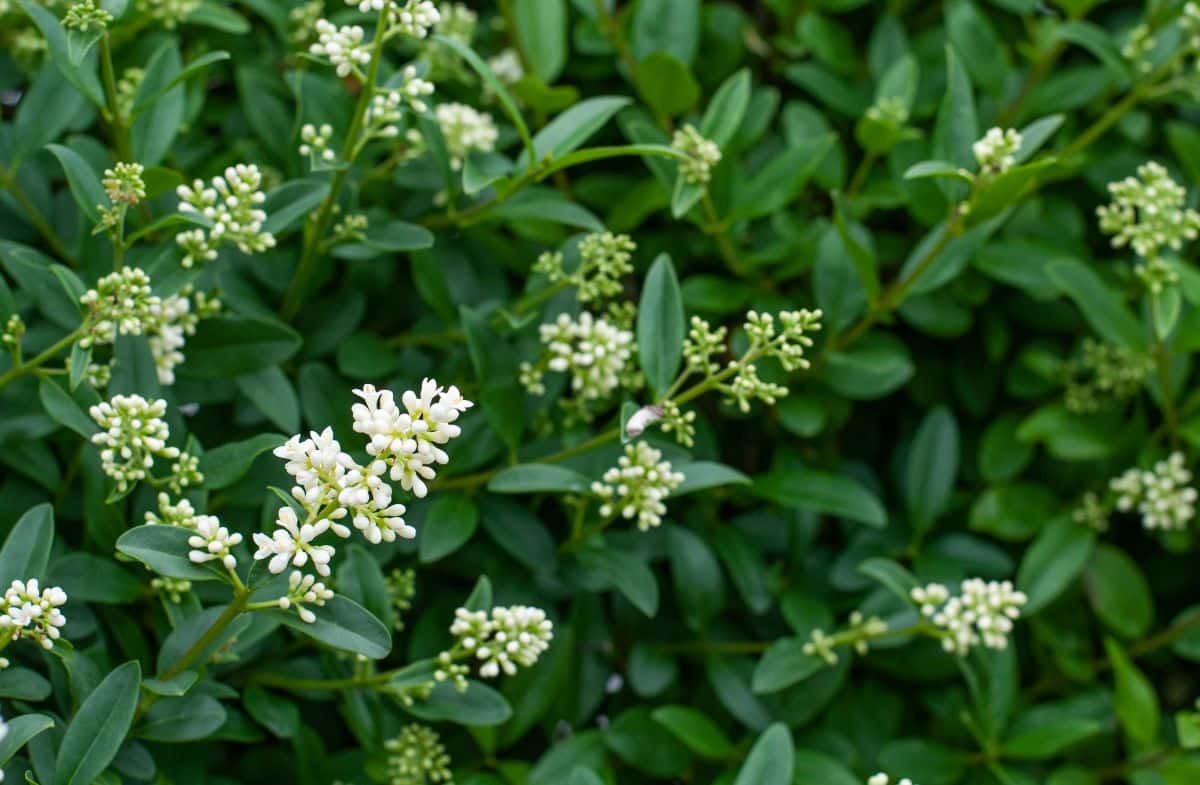
| Plant name: | Privet |
| Watering requirements: | Moderate |
| Lighting requirements: | Full sun |
| Growing zone: | Zones 6 o 8 |
| Other benefits: | Fast growth rate; fragrant flowers; great for sculpting; somewhat tolerant to road salt. |
If you just bought a new home and you want to create a more private yard in a short period of time, privet is one of the best solutions. This fast-growing evergreen bush can grow up to 2 to 3’ feet per year, making it just right for creating a living wall to shield your garden. However, with that fast growth rate, keep in mind that your privet will need frequent pruning too.
Growing up to 15’ high, privet produces a wealth of fragrant, foamy, white flowers in spring and summer. It is also resistant to many pests and diseases and is deer-proof too. Even better, it’s drought-tolerant once established and requires very minimal care.
5. Bamboo (Bambusa spp.)
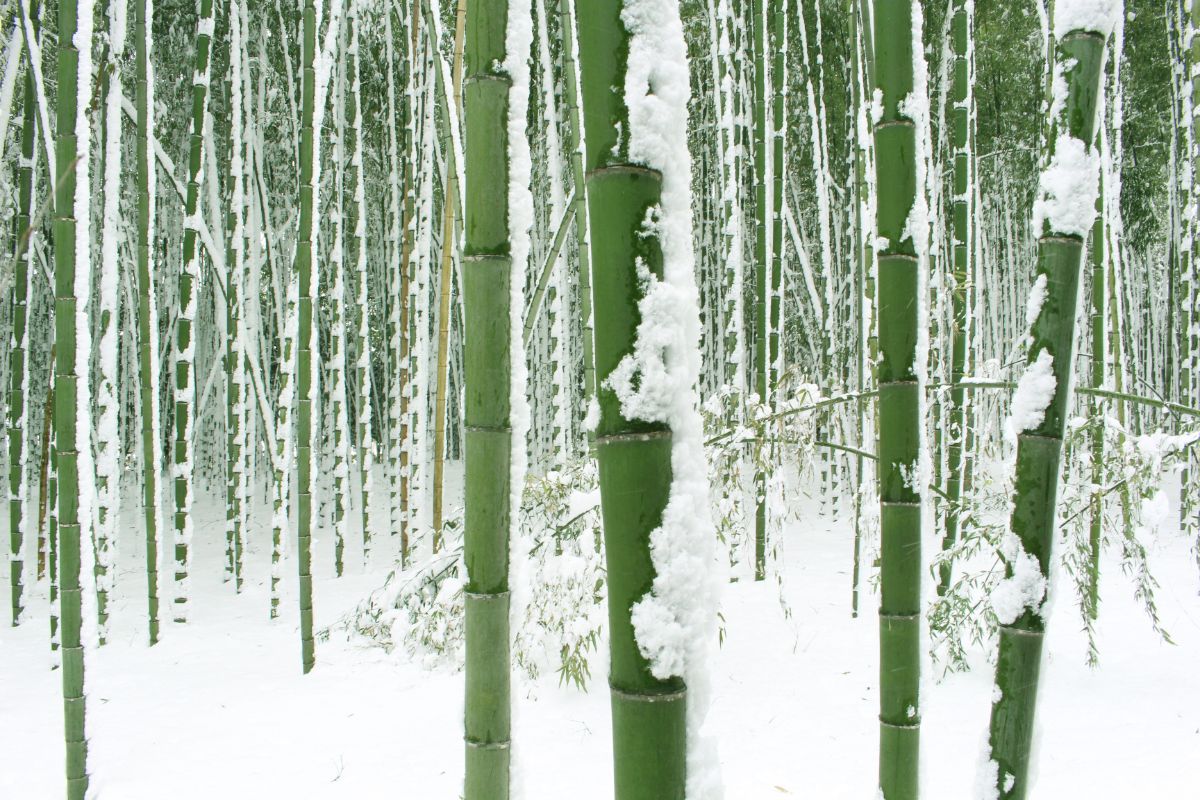
| Plant name: | Bamboo |
| Watering requirements: | Moderate to low |
| Lighting requirements: | Full sun |
| Growing zone: | Depends on variety |
| Other benefits: | Fast growing; creates interesting sounds with the breeze. |
Once established, bamboo will create a thick wall of canes and gorgeous leafy greens that move beautifully in the wind and create a relaxing sound too. While bamboo will usually drop its leaves in winter in cold locations, the densely packed canes still provide plenty of coverage. If you’re trying to create a Zen-like feel in your garden space, bamboo is the absolute best privacy plant to grow.
Bamboo is, at times, notorious for its fast growth rate, so if you decide to use this plant as a privacy screen, be sure to look for non-invasive, slow-spreading, and clumping types. Some good clumping bamboo varieties to try include Alphonse Karr, Fasca, and Gracillis.
If you have a smaller garden space, bamboo can be kept in pots, too; however, it will need regular watering – up to 3 times a week. Bamboo planted directly in garden soil is relatively drought-tolerant once established, especially if you choose a variety that’s known for growing in drier climates.
6. Boxwood (Buxus spp.)
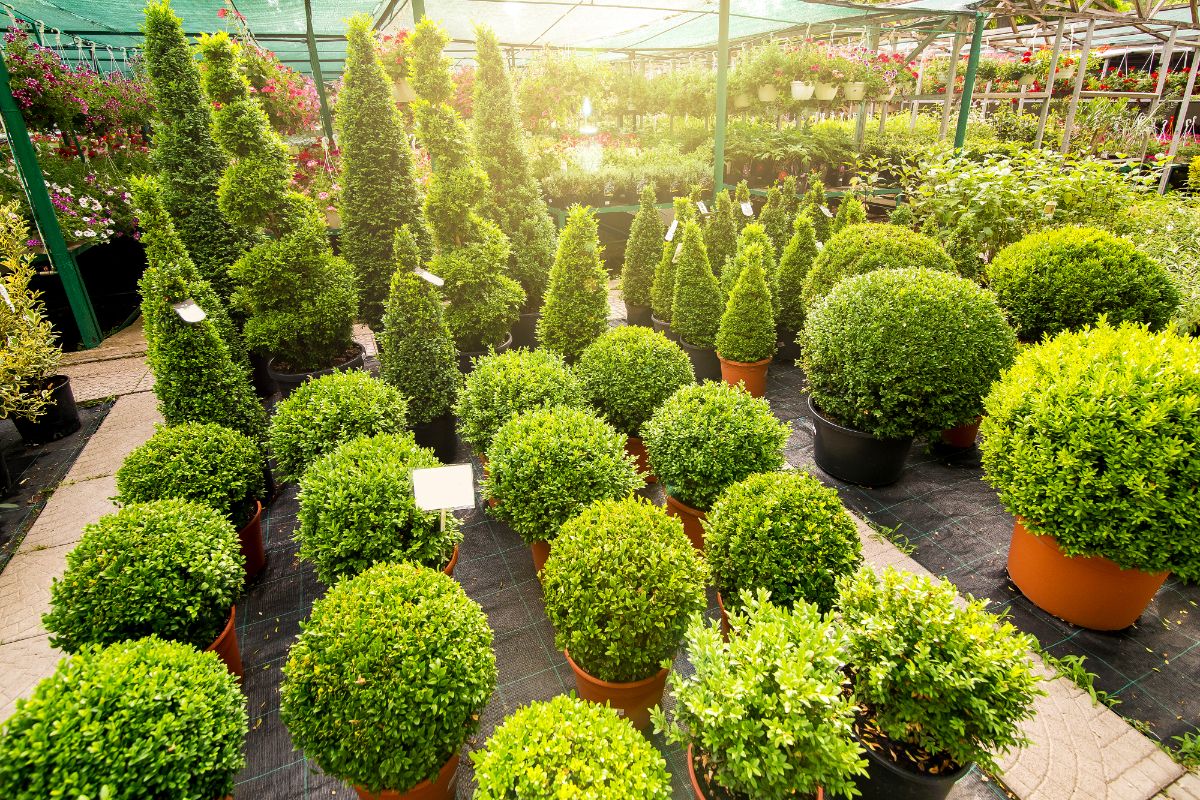
| Plant name: | Boxwood |
| Watering requirements: | Moderate to low |
| Lighting requirements: | Full sun to part shade |
| Growing zone: | Zones 5 to 9 |
| Other benefits: | Great for sculpting; drought tolerant once established. |
A staple plant in topiary designs and knot gardens, boxwood is another fine choice for winter privacy. These hardy evergreens have shiny, rounded leaves that excel at water retention, making these plants naturally drought tolerant. Boxwoods are also undesirable to deer, so they are a good plant to try if your area has a large deer population.
Boxwoods benefit from regular pruning, which is best done in spring. Thereafter, these plants tend to retain their shapes well as they are comparatively slow growing. That means that you can take your time sculpting your boxwood hedge into the perfect shape to complement your garden space.
As a privacy hedge, many gardeners choose to trim their boxwoods into careful, straight lines; however, this plant can hold more unique looks, like rounded globes or more figural shapes.
7. Cotoneaster (Cotoneaster spp.)
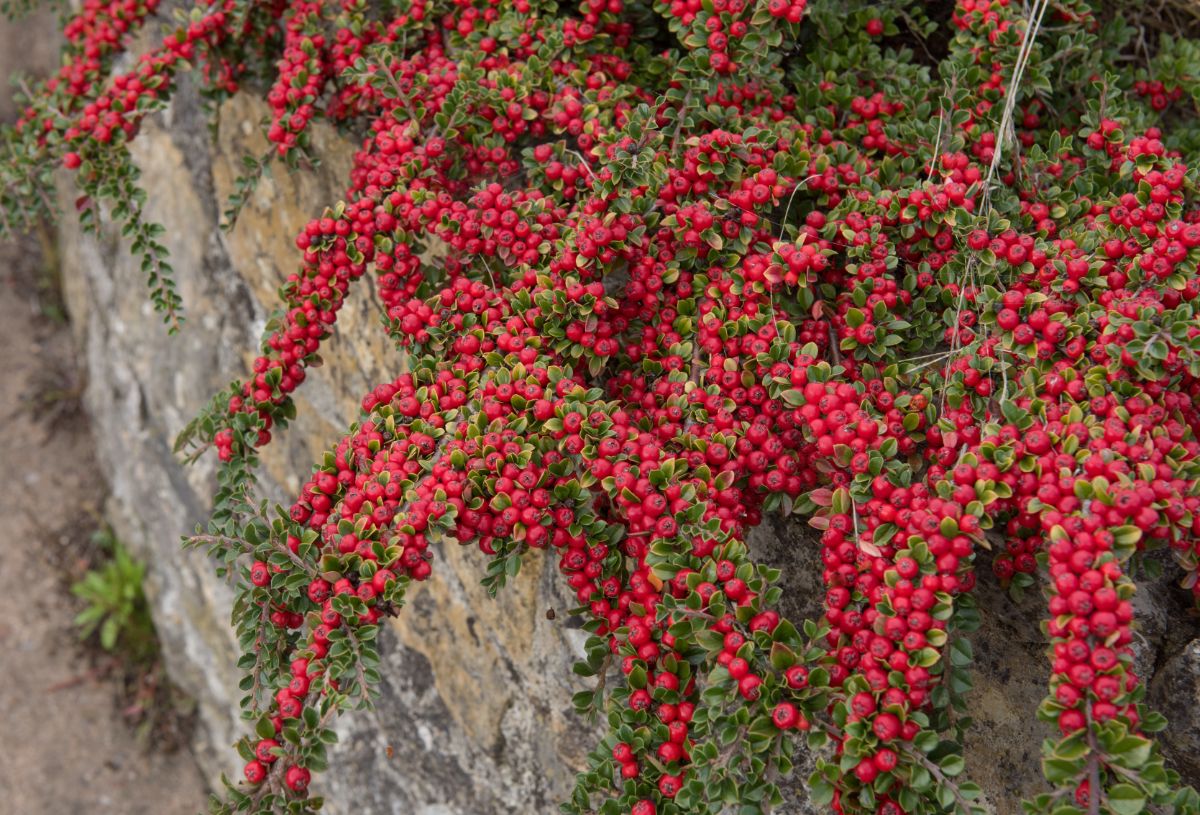
| Plant name: | Cotoneaster |
| Watering requirements: | Moderate to low |
| Lighting requirements: | Full sun |
| Growing zone: | Zones 5 to 8 |
| Other benefits: | Berries attract wild birds; drought tolerant once established. |
Cotoneasters are no-fuss plants that offer tons of benefits to backyard growers. They are naturally resistant to deer and rabbits and can tolerate some road salt too, so they can be planted near property lines. They also produce a profusion of red berries in winter, which are a hit with birds and other wildlife.
There are hundreds of different types of cotoneaster, so it’s important to do your research and choose the right one for your space. Some varieties are deciduous, while others keep their leaves all year long. Certain types of cotoneasters also grow taller than others, making some better suited as privacy screens.
‘Franchet’s’ cotoneaster, for example, has gently arching branches that can be left to grow wild or pruned for a neater appearance. An evergreen plant, ‘Franchet’s’ can grow up to 10’ high and is well-suited for creating a garden privacy screen. ‘Himalayan,’ ‘Grayleaf’ and ‘Late’ also make good privacy plants.
8. Yew (Taxus baccata)
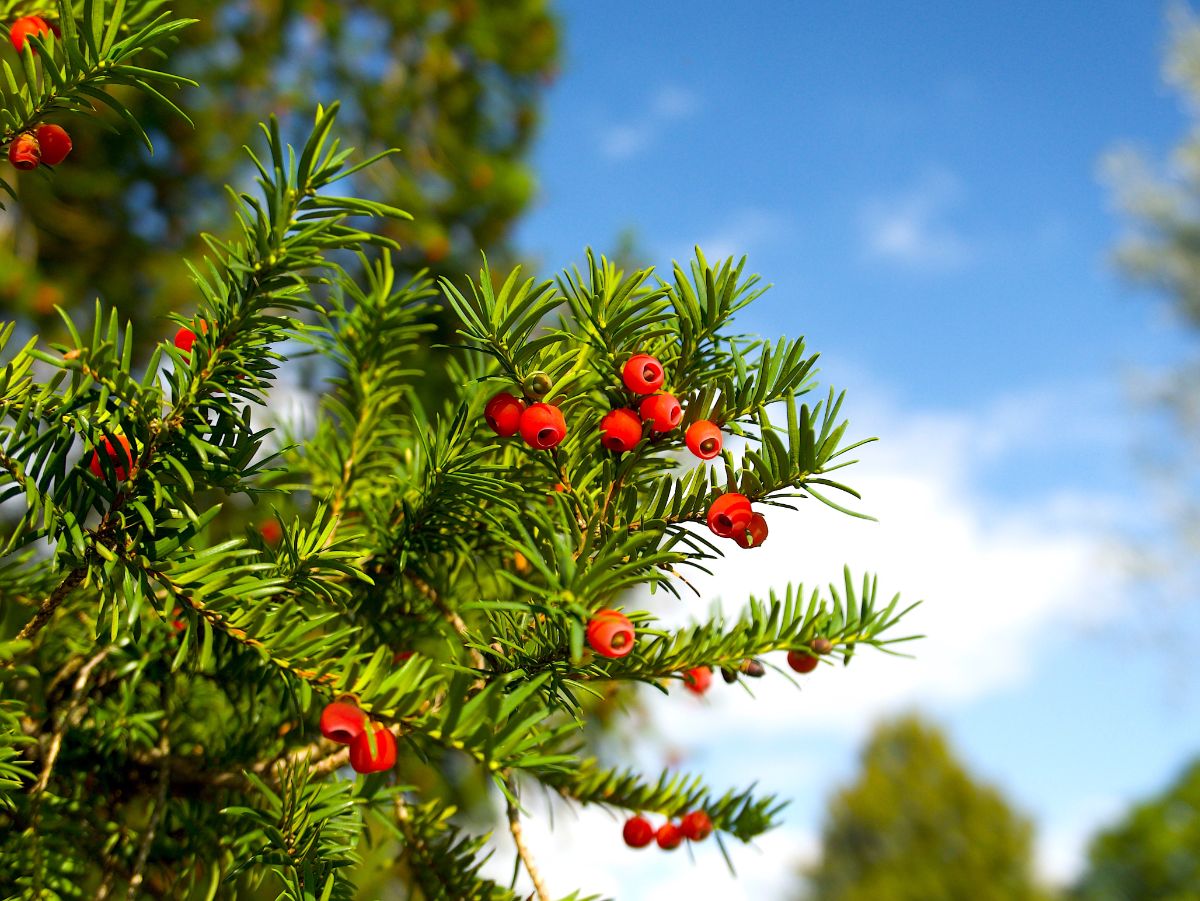
| Plant name: | Yew |
| Watering requirements: | Low |
| Lighting requirements: | Full sun to full shade |
| Growing zone: | Zones 4 to 8 |
| Other benefits: | Berries attract birds. |
Yews are traditional privacy plants known for their soft, needle-like leaves and bright red berries. While yews can be planted in different ways, they are often used as foundation plants for garden beds and landscapes with smaller ornamentals planted around them. They also make spectacular privacy screens along driveways or back patios.
A hardy plant, yews can tolerate colder temperatures and are appropriate for planting in areas as chilly as zone 5. They are also naturally pest-resistant and drought-tolerant (once established), and they can handle different soil types too. Mature yews will grow up to 12’ high, and their thick growth makes an excellent, natural shelter for overwintering birds.
Just keep in mind that all parts of yew shrubs (especially the berries) are toxic, so care should be taken if you have small children or pets around.
9. Mountain Laurel (Kalmia latifolia)
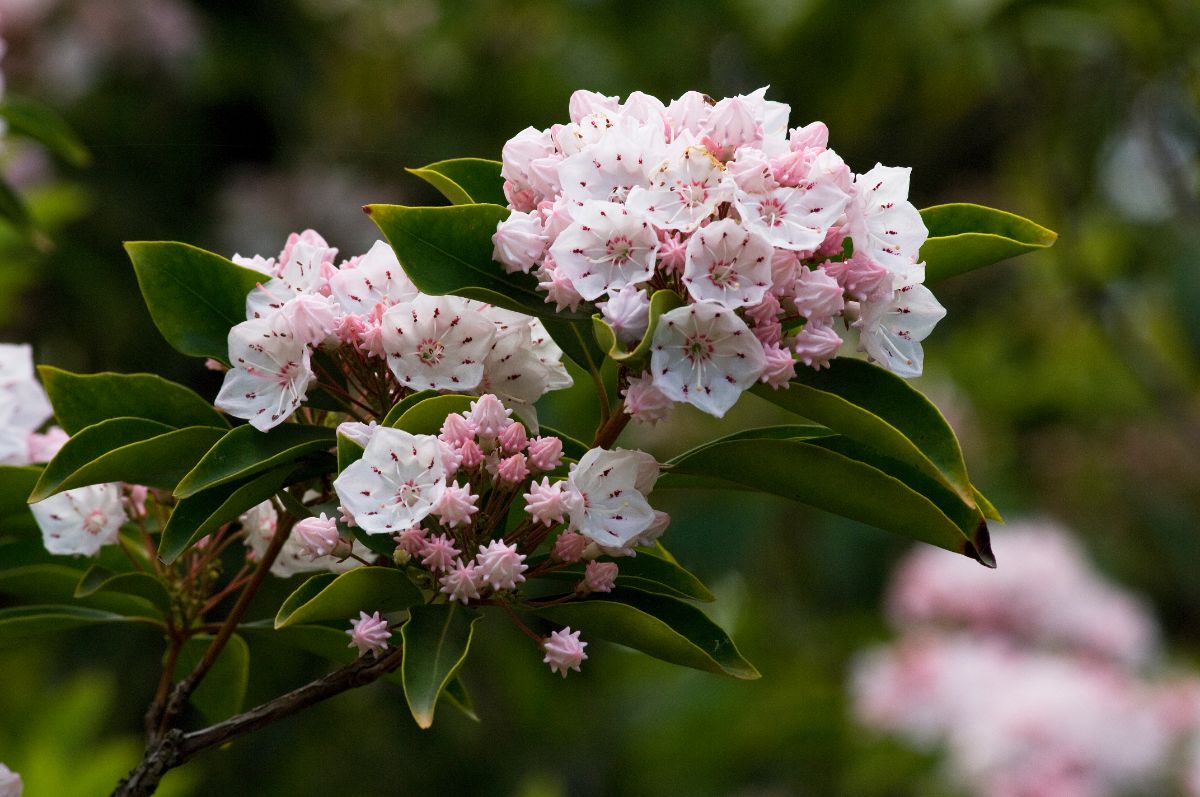
| Plant name: | Mountain laurel |
| Watering requirements: | Moderate to low |
| Lighting requirements: | Full sun to full shade |
| Growing zone: | Zones 5 to 9 |
| Other benefits: | Flowering ornamental; pollinator favorite; drought tolerant once established. |
A relative of azaleas and rhododendrons, mountain laurels are often overlooked as privacy plants, which is a shame. These gorgeous shrubs are incredibly easygoing, bloom beautifully, and are more cold-tolerant than rhododendrons too!
An evergreen shrub growing up to 15’ high, mountain laurels have thick and leathery leaves that hold their color all year. Those leaves also make these plants naturally drought-tolerant and pest resistant, although deer may still seek out mountain laurel leaves.
While mountain laurel’s rich leaf color looks beautiful in the winter garden, these plants really come alive in springtime when they begin to bloom. Flowers are uniquely shaped, appearing a bit like an origami bowl, with petals in pink, red, and white.
10. Azaleas and rhododendron (Rhododendron spp.)
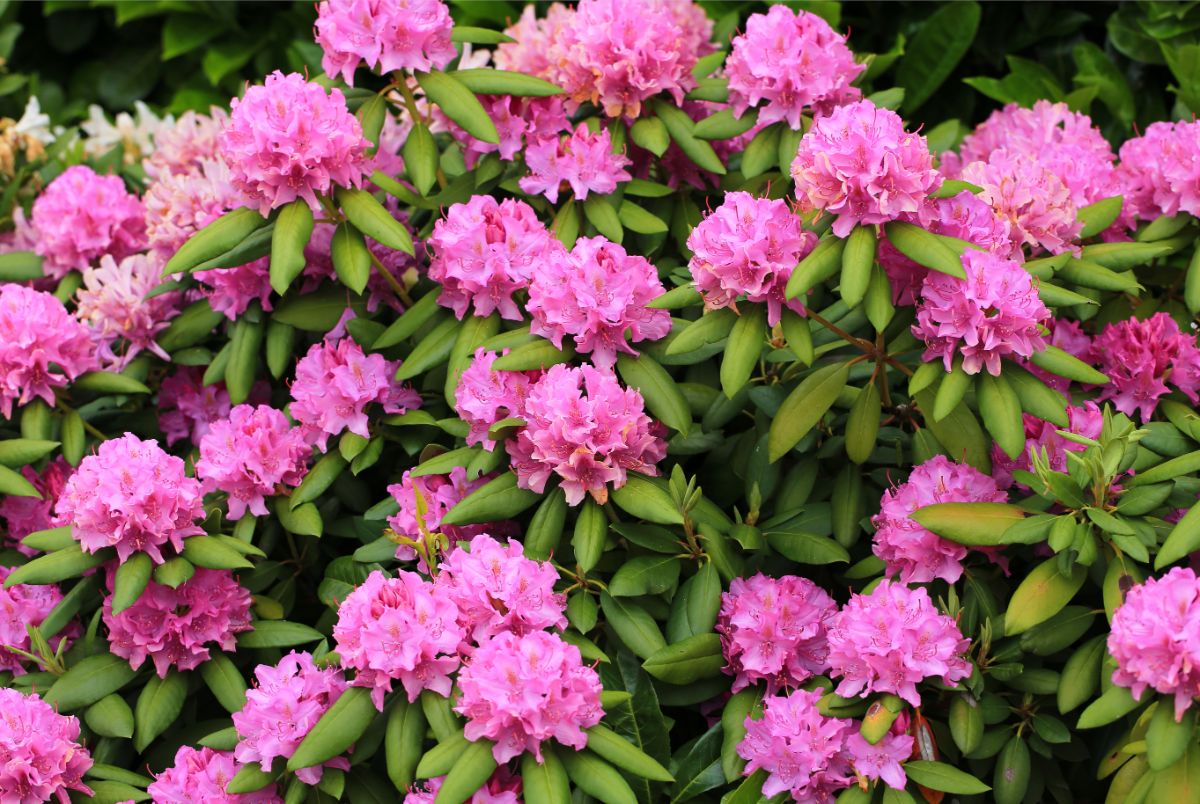
| Plant name: | Azaleas and rhododendron |
| Watering requirements: | Moderate |
| Lighting requirements: | Full sun to part shade |
| Growing zone: | Depends on variety |
| Other benefits: | Flowering ornamental. |
Azaleas and rhododendrons are two closely related plants. In fact, azaleas are actually part of the rhododendron family. However, there are a few key ways to tell these two plants apart.
Azaleas are often smaller than rhododendrons and have flowers that are more widely spaced. Azalea leaves are also frequently deciduous, although evergreen azaleas keep their leaves all year round. Rhododendrons, on the other hand, are usually larger, have flowers that form in clusters, and produce thick, leathery, evergreen leaves.
Both rhododendrons and evergreen azaleas make exceptional privacy plants thanks to their tall and dense growth and evergreen leaves. Even better, in spring to early summer, these plants bloom a profusion of flowers in pink, purple, and white.
11. Leyland cypress (Cupressus × leylandii)
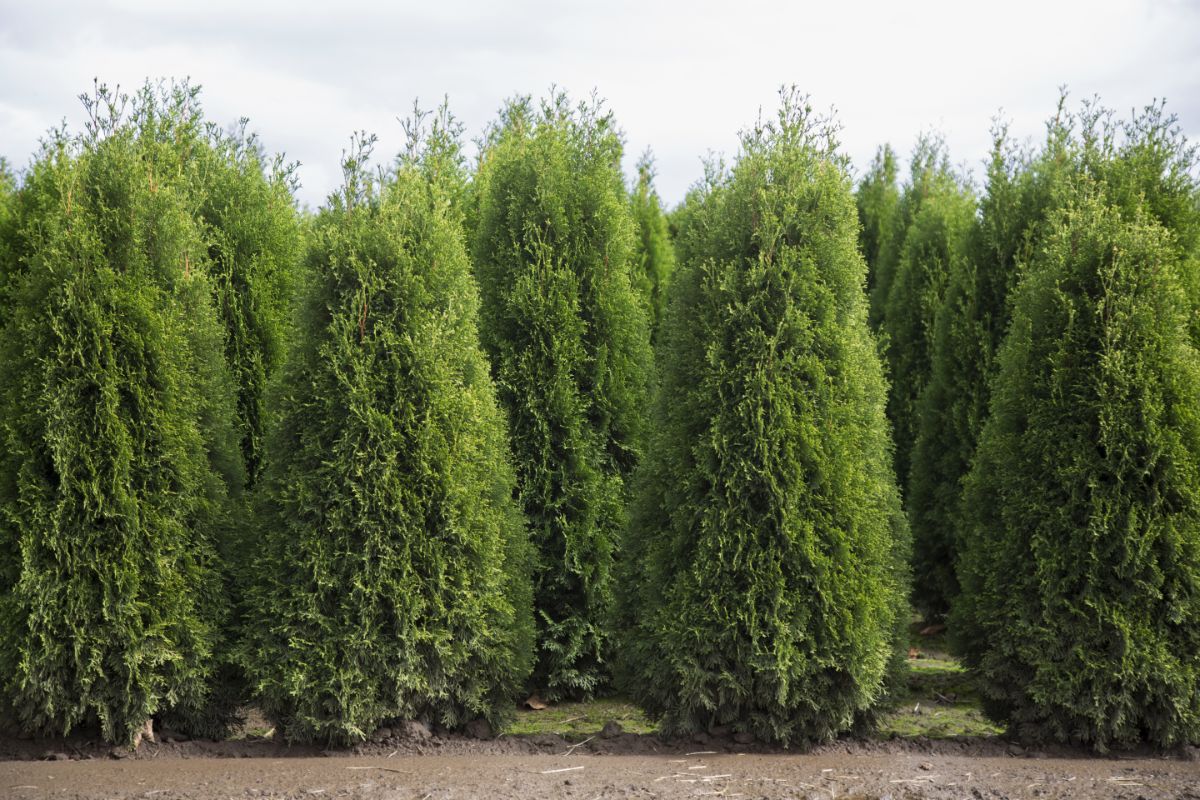
| Plant name: | Leyland cypress |
| Watering requirements: | High to moderate |
| Lighting requirements: | Full sun to part shade |
| Growing zone: | Zones 6 to 10 |
| Other benefits: | Fast growing; tolerant to road salt. |
One of the most popular privacy trees in North America, the Leyland cypress is famed for its fast growth rate and general hardiness. Growing about 3 to 5’ a year, Leyland cypress will quickly create a thick barrier around your garden space. Once mature, trees can reach about 50’ in height; however, you can prune them off when they reach the height you want, and the plant will redirect its energy toward horizontal growth.
While many privacy plants can be fussy about their care requirements, Leyland cypress will grow well in poor soil and part shade. It also has a high salt tolerance, making it able to grow near busy winter highways.
12. Skip Laurel (Prunus laurocerasus 'Schipkaensis')
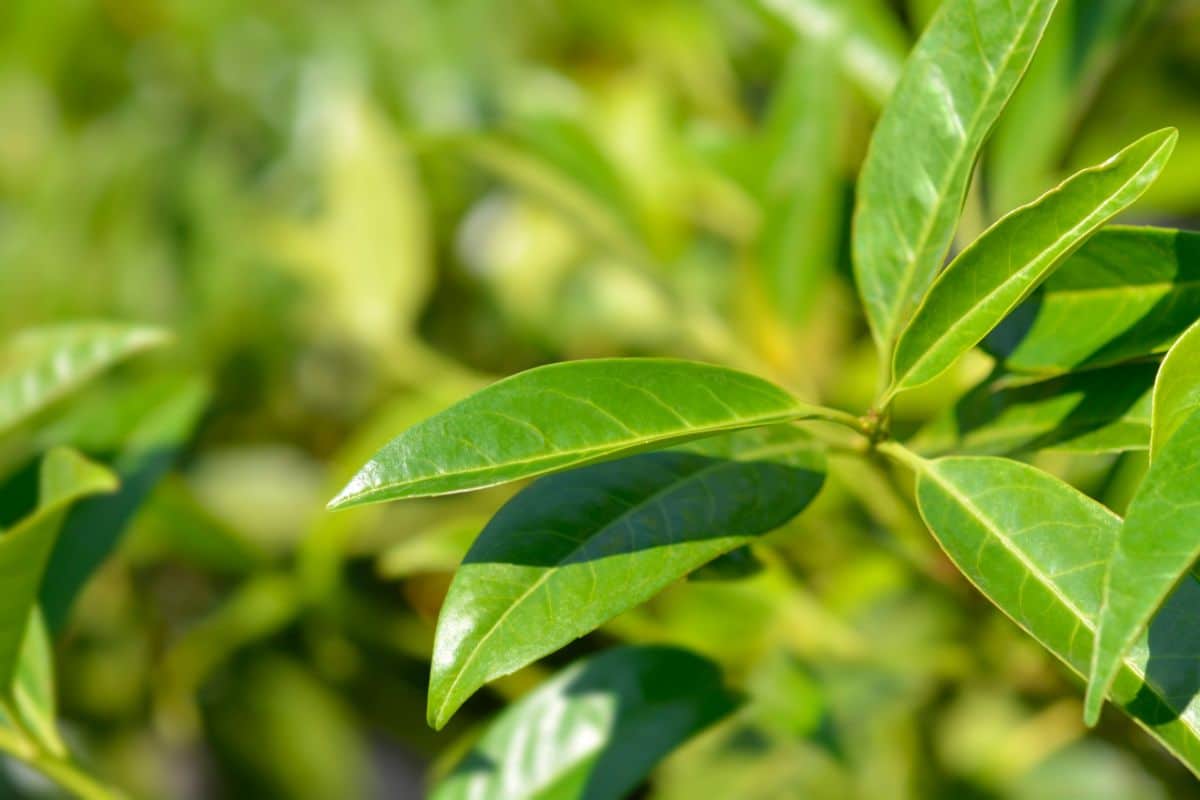
| Plant name: | Skip laurel |
| Watering requirements: | Low |
| Lighting requirements: | Full sun to part shade |
| Growing zone: | Zones 5 to 9 |
| Other benefits: | Flowering ornamental; drought tolerant once established. |
Another fast grower, skip laurels grow about 2’ per year and are very dense for maximum garden privacy. They also offer fine leaf forms that lend themselves well to pruning and can be used to create nice, clean lines in your hedgerow.
A hardy evergreen, skip laurel doesn’t like bright sun, which makes it a good plant to try if you have a shadier garden space. It can also tolerate different soil types and is generally low maintenance overall, although it can benefit from additional waterings if the weather has been very dry. In springtime, expect your plant to produce fragrant white flowers, which bees love!
13. Juniper (Juniperus spp.)
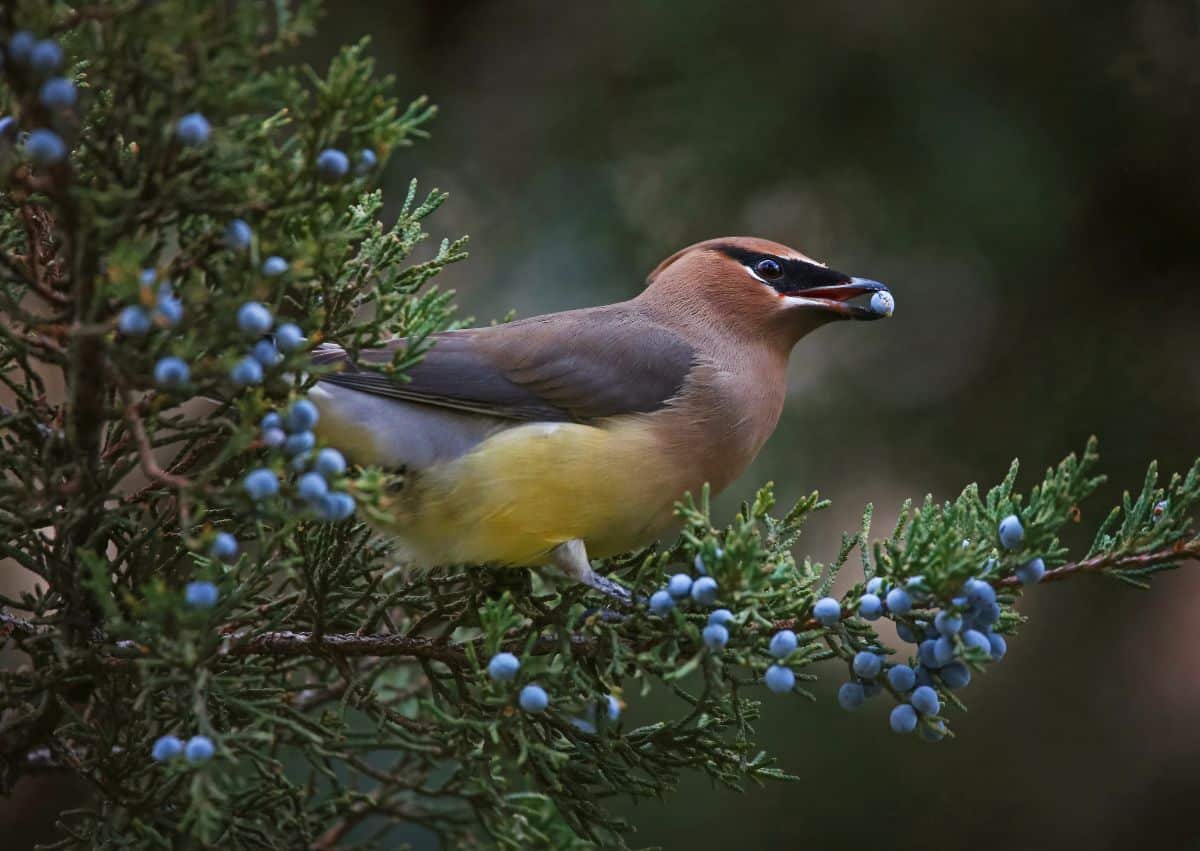
| Plant name: | Juniper |
| Watering requirements: | Low |
| Lighting requirements: | Full sun |
| Growing zone: | Zones 2 to 7 |
| Other benefits: | Berries attract birds; drought tolerant once established. |
Some of the hardiest privacy plants you can find, some varieties of juniper can grow well in areas as cold as zone 3. Their bluish-green foliage will add lots of winter interest to garden beds, which is only augmented by the greyish-blue berries this plant produces in fall and winter. Those berries are much loved by eastern bluebirds and other wild bird species.
As a privacy hedge, juniper can grow up to 50’ high and maintains a nice, natural texture in garden beds or planters. Watering your plant well in autumn and early winter can help protect juniper from winter damage. A good rule of thumb with this plant is to continue watering until the ground freezes if your location is not receiving much rain.
14. Cedar (Juniperus virginiana, Thuja plicata, and others)
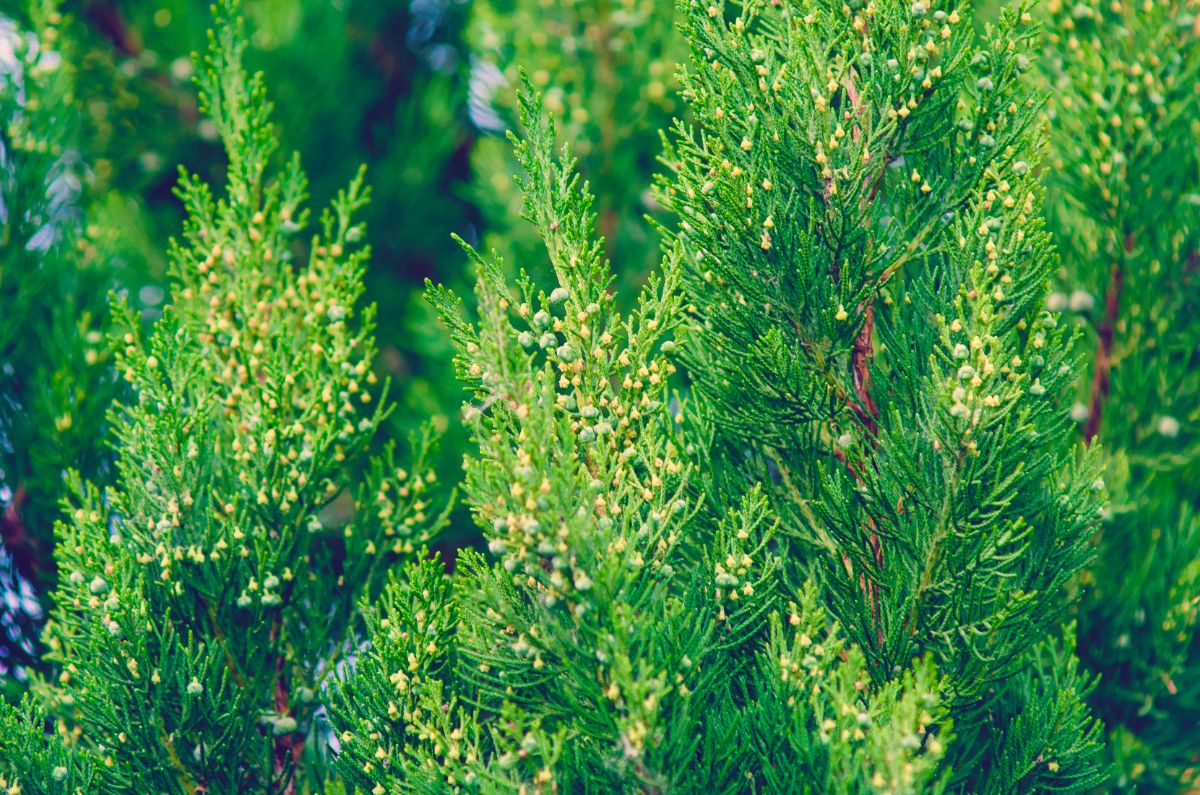
| Plant name: | Cedar |
| Watering requirements: | Low |
| Lighting requirements: | Full sun to part shade |
| Growing zone: | Depends on variety |
| Other benefits: | Berries attract birds; drought tolerant once established. |
Cedars are attractive evergreen trees with slightly prickly foliage that can keep unwanted pests and visitors away. They are naturally deer resistant, cold-hardy, and very adaptable. In fact, you can find these plants naturally growing in dry and rocky landscapes or along moist and swampy areas.
There are several different types of cedar that are recommended for backyard growers, with eastern red cedar and western red cedar being two of the most popular options. These plants can grow up to 50’ high and make excellent windbreaks and shelter for wildlife, in addition to being ideal privacy screens.
15. Other evergreens
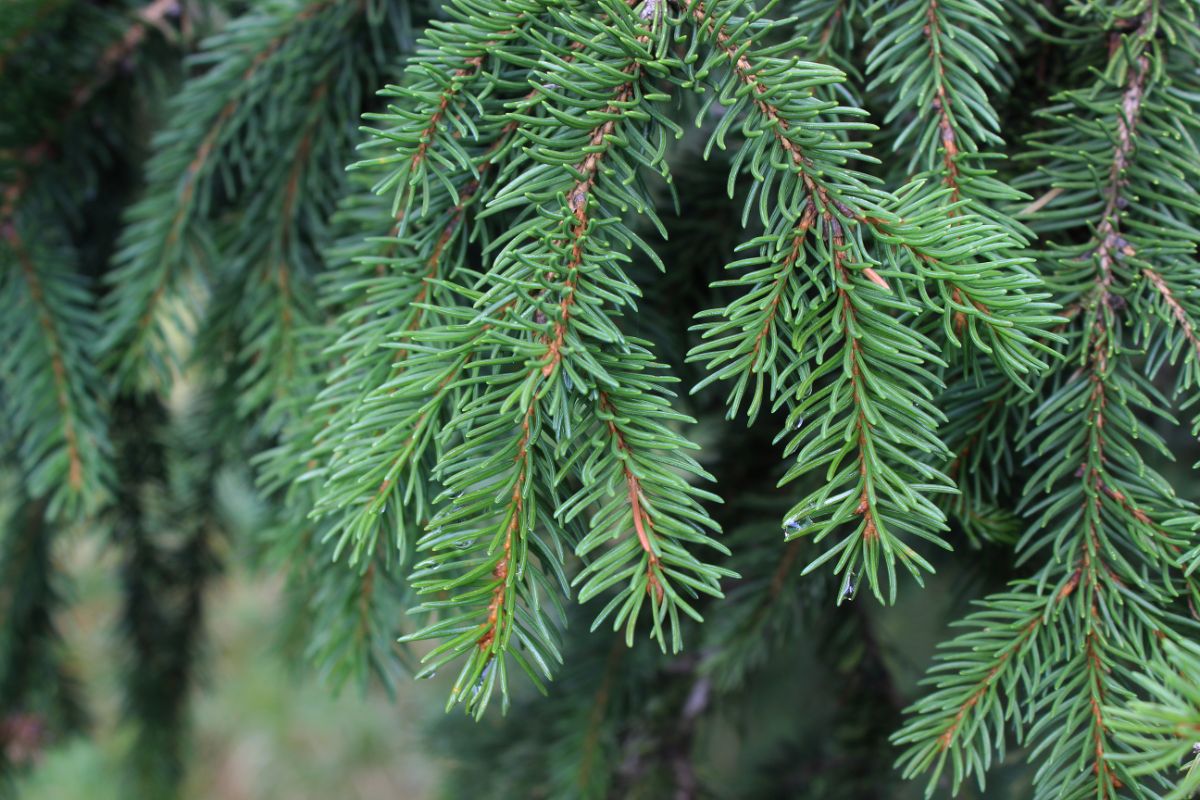
| Plant name: | Other evergreens |
| Watering requirements: | Depends on variety |
| Lighting requirements: | Depends on variety |
| Growing zone: | Depends on variety |
| Other benefits: | Dense growth provides excellent shelter for birds and wildlife. |
Various species of pines, firs, and spruces are also excellent choices for creating backyard privacy. Some species can grow very large, 50’ high, or taller, while others remain much smaller and are just right for fencing off backyard patios and other smaller garden spaces.
While there are too many different types of evergreen trees to cover, some popular choices for privacy screens include blue spruce, white spruce, Norway spruce, concolor fir, Douglas fir, Austrian pine, and white pine.
Evergreen trees not only provide plenty of privacy. They can also form the foundation of your landscape design, offer natural shelter for wildlife, function as windbreaks in inclement weather, produce shade, and much more.
Frequently Asked Questions
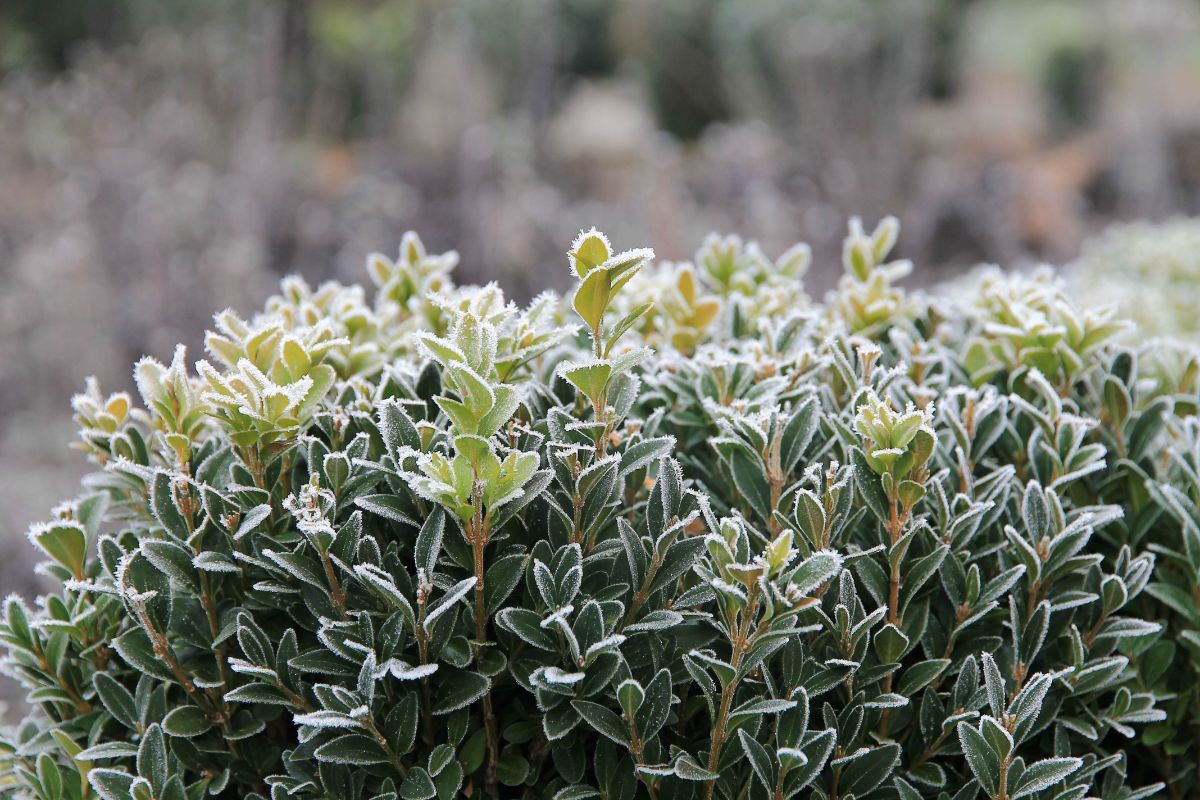
If you’re looking for a fast-growing plant for winter privacy, privet, bamboo, and Leyland cypress are some of the best choices. Other good, deciduous options include clematis, ivy, and climbing roses.
Arborvitae, privet, boxwood, and Leyland cypress are known for their dense growth habit that is perfect for creating a more private feel in your garden space. These plants are all evergreens too, which means they’ll help to shelter your yard all year round.
Fast-growing, evergreen plants are some of the best choices for creating a living fence between your neighbor’s home and your own. Plants like arborvitae, juniper, and cedars are all perfect picks that will create more privacy and look beautiful too!
Beyond planting privacy plants, installing a quality fence or rock wall can help delineate your outdoor space. For a quicker fix, large container planters with tall plants, like bamboo, millet or amaranth, can help too.
Summary
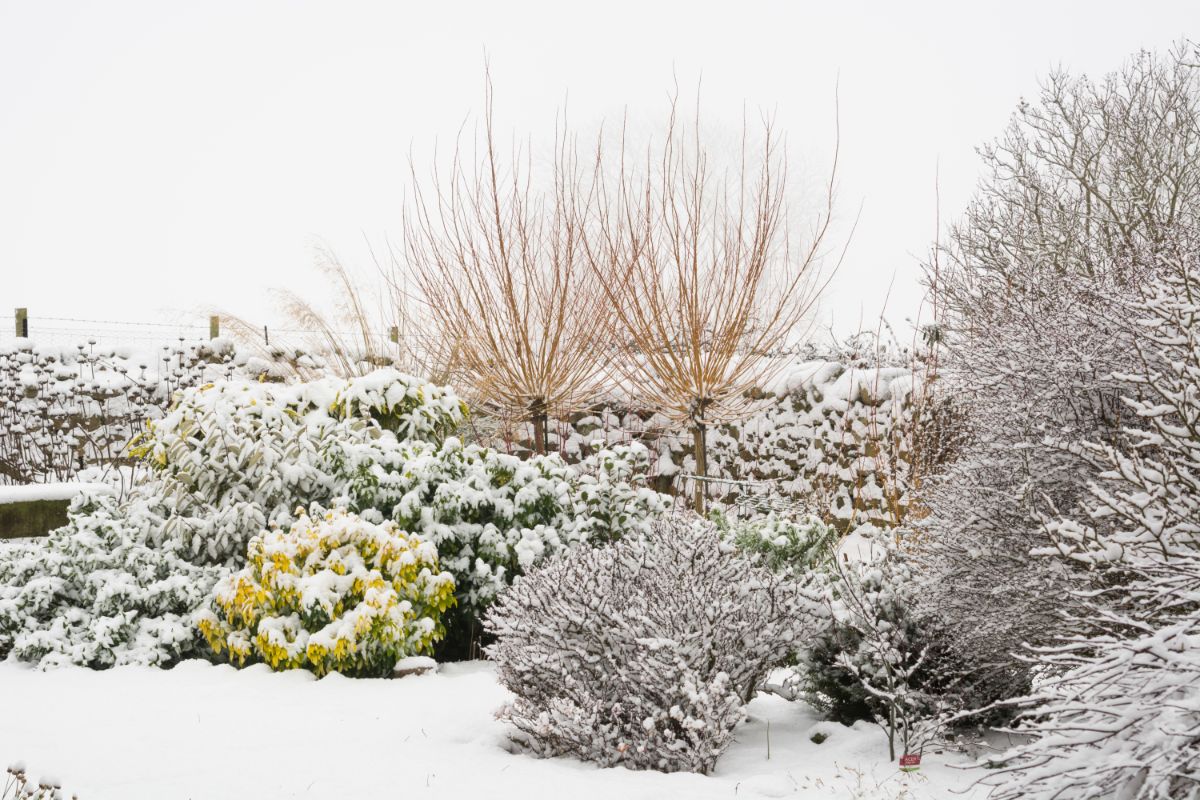
If privacy is important to you while you’re outdoors working in your garden, you may want to consider ways to create a more sheltered outdoor space. This is easy enough to accomplish during spring and summer when plants and trees are heavy with leaves. But when leaves begin to fall in autumn, maintaining garden privacy can get a bit trickier.
Luckily, there are lots of evergreen and other types of plants that will help you keep your garden feeling sheltered and protected all year round. We’ve covered some of our top choices in this article today, and we hope that you’ve found inspiration for your garden design.
If you’re still looking for suggestions for increasing your garden’s privacy, check out our article on fast-growing hedges here.

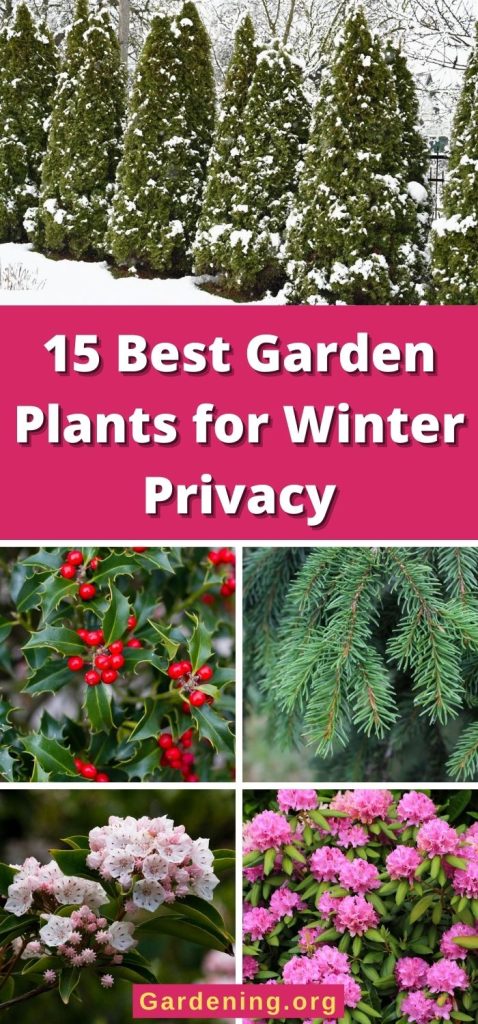
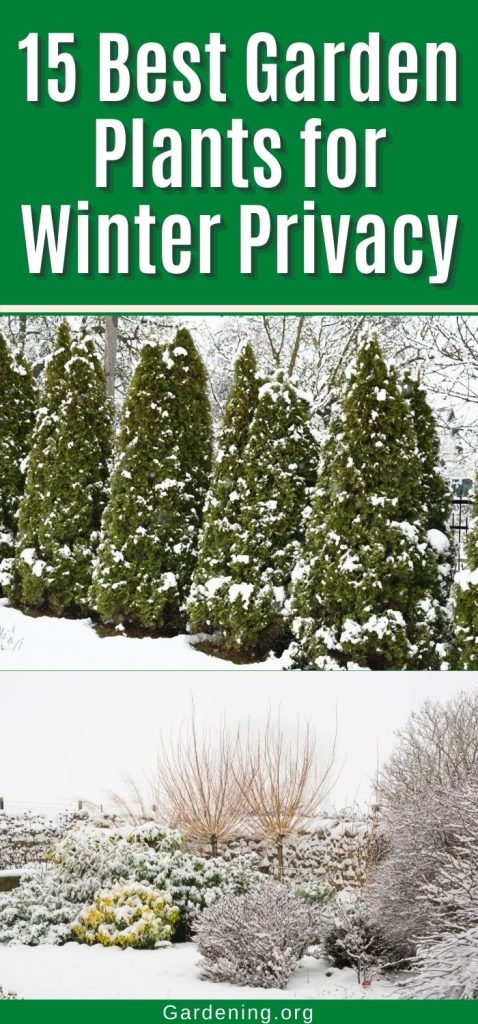
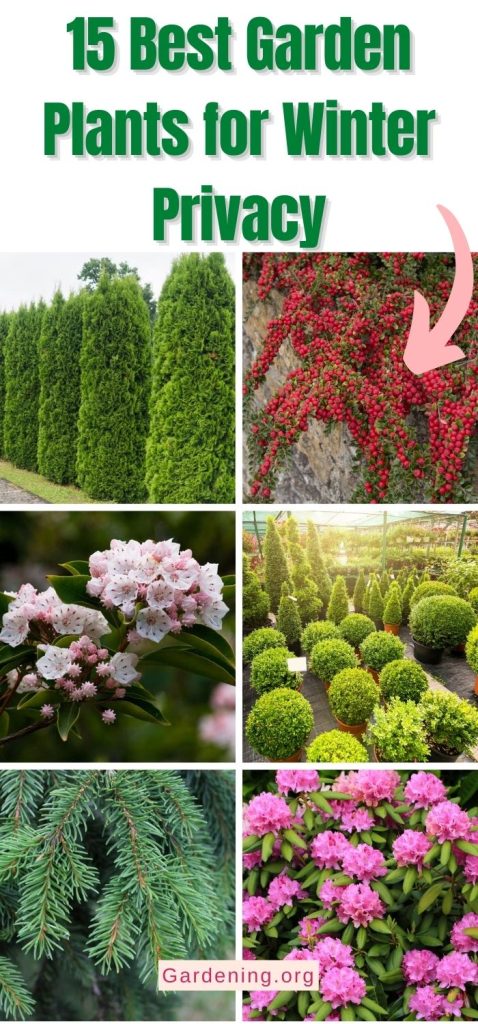
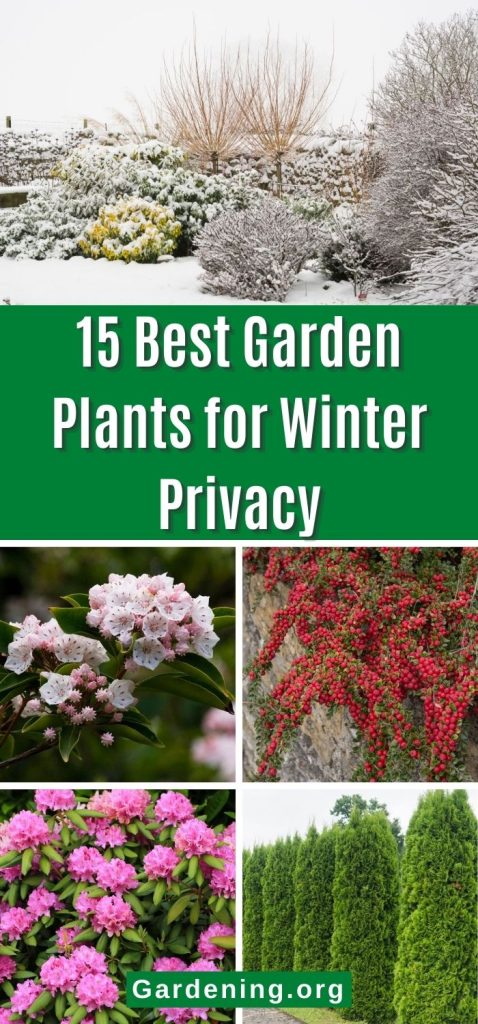
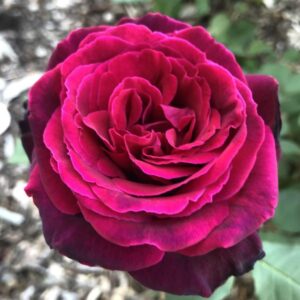

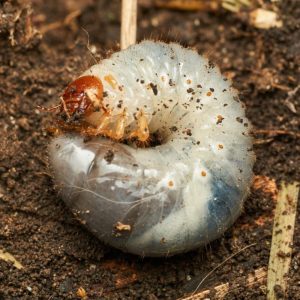
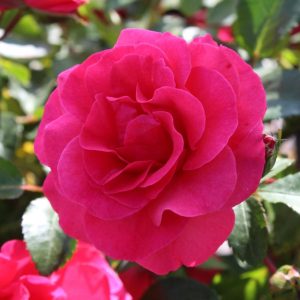
Leave a Reply